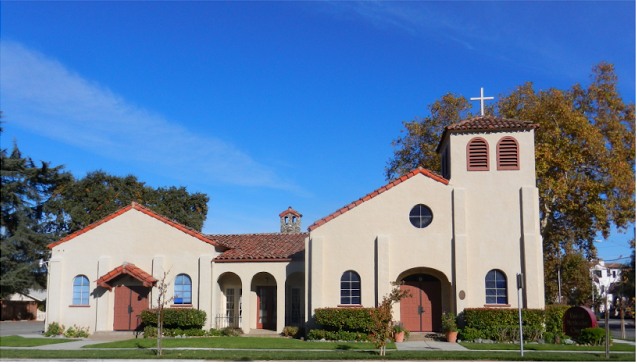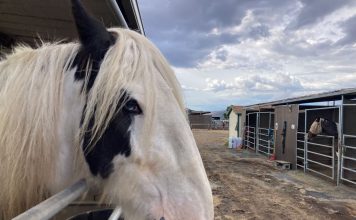
Imagine my surprise when I received a phone call from a woman who said she had some Gilroy history to return our town. Her name was Carol Cox Faust, and it turned out that her father had been Rev. Ezelle Cox, pastor of the Methodist Church of Gilroy in 1938 when it burned to the ground.
When Cox arrived in Gilroy, she brought with her a wealth of artifacts, articles and documents saved by her late parents and then by herself for 75 years—even though they had long ago moved far from Gilroy.
Her parents had been a big part of making it possible to rebuild the church, and her mother, Arline Cox, had kept a very detailed scrapbook and journal describing the process of bringing the church back to life including articles clipped from the Gilroy and San Jose newspapers of 1938, the original architect’s drawing depicting the church as it would rise from the ashes and other historical papers telling the church’s history.
This is a significant return of a piece of Gilroy’s history, since the original Methodist Episcopal Church, South, was the first church of any kind ever organized 161 years ago in Pleasant Valley, as Gilroy was named back then. It predates all other churches.
It tells the story of how the Methodist Episcopal Church, South, first met on June 4, 1853 with 13 members and three probationers present. The Trustees Report for 1855 said “during the year they have built a good house of worship estimated to cost $1,000.” It was described as 20-by-40 feet in size, “a frame building painted inside and out, with good seats.”
A committee was formed to raise funds for buying furniture (cost: $37.50) and a carriage for the pastor. In 1862, they constructed a stable for $32.
Church member John R. Bane was the first school teacher in Gilroy in the public school system in 1853, the first year of the church.
The early church rolls read like a who’s who of local street names: the Rea family, Dowdy family, Eigleberry family and the Rucker family were members and contributors to the church. Later, the Chesbro and Hanna families were very active members also.
Another branch of the Methodist Church began meeting together in Gilroy in 1857 and became thought of as the “north” Methodist Episcopal church. They contributed to the Freedman’s Aid Society, organized to help African-Americans. In 1870, a special meeting of the Board of Trustees of the High School was called to consider whether African-American children should be admitted to the privileges of the school. J.C. Zuck, a Methodist lay leader who was very active in the community, spoke on behalf of “the colored children,” as it was worded in the records. However, in spite of his appeal, the School Board resolved not to admit them.
There were Chinese Methodist church members in the early 1900s, as well as a Japanese Sunday school in 1910. It was interesting to me to note that Methodists worked with migrant families then just as they do today in Gilroy.
When the flu epidemic of 1919 swept through Gilroy, it was so severe that church services in the new larger church in Gilroy had to be discontinued. The church became a hospital for Japanese patients. Dr. Okawa had to split his time between Watsonville and Gilroy; sometimes the exhausted doctor collapsed and slept in the pastor’s study.
Just as they do today, the Methodists had an ecumenical outlook and collaborated with other churches in the community. The Baptists needed a meeting place and occupied the building two Sundays a month. In 1868, during the Smallpox Epidemic of 1868, the Presbyterians and both Methodist churches met together.
On March 23, 1917 it was resolved that the South church’s smaller building would be sold and added to the north Methodist Episcopal Church building; the combined building required remodeling at a cost of more than $16,000 (more than $250,000 today).
The union of the southern and the northern Methodist churches in Gilroy marked a new day. The time had come when it was better to give the time and attention to a united program, rather than to separate and competing enterprises.
Imagine church members’ devastation when the grand new building was completely destroyed by fire. On Nov. 13, 1938 a furnace exploded, and a 36-year-old volunteer firefighter named Russell Heck was killed trying to save the church.
Members stood by helplessly watching the walls of their church crumple to the ground. But as they watched, there were no thoughts of calling it quits but rather a serious determination sprang forth that “We shall build again.”
Next time: the story of how church members, the Gilroy fire chief and people from all parts of the Gilroy community came together to rebuild the United Methodist Church “free of debt” in less than seven months!












